Loading docks are some of the busiest—and most high-risk—areas in any facility. As operations ramp up heading into winter, safety can sometimes take a back seat to efficiency. But all it takes is one incident to disrupt production, damage equipment, or put a team member at risk.
The good news? A few proactive checks can make all the difference.
Here’s a complete loading dock safety checklist to keep your operations safe, efficient, and winter-ready.
Loading Dock Area Safety Tips
Start by addressing the most active—and most hazardous—zone in your facility: the loading dock area itself. Regular inspections and clear safety procedures help prevent loading dock accidents.
- Limit access to authorized personnel only. Keep the dock area clear of unnecessary foot traffic. Limiting access reduces the risk of accidents and helps your team focus on safe, efficient loading and unloading.
- Keep it clean and clear. Snow, ice, and debris can quickly create hazards. Make sure the dock floor, ramps, and stairways are free from spills or obstructions—especially during freeze–thaw cycles.
- Check your lighting. With shorter days and early sunsets, good lighting is essential for visibility and safety. Confirm that all dock and exterior lights are functioning properly.
- Inspect dock levelers. A reliable dock leveler bridges the gap between your dock floor and truck trailers safely.
- Hydraulic levelers are best for heavy loads and frequent use.
- Mechanical levelers ensure operation even in a power outage. Schedule a pre-winter dock leveler inspection to make sure your levelers are performing as they should.
- Mark hazards and emergency exits. Clearly label edges, blind corners, and any areas with stored materials. Add mirrors where visibility is limited, and confirm that exits and emergency routes are easy to locate.
- Check safety and emergency supplies. Fire extinguishers, first aid kits, and defibrillators should be fully stocked, easy to access, and clearly marked. Review expiry dates and restock if needed.
- Seal it tight. Cold air, snow, and freezing rain can make surfaces slippery and increase energy loss. Keep dock doors closed and sealed when not in use. Installing or upgrading an adjustable curtain dock seal helps block out drafts and prevent wet floors.
- Stay proactive with maintenance. Preventative maintenance beats emergency repairs every time. Inspect dock equipment—restraints, bumpers, doors, lights, and communication systems—before winter conditions make service more difficult.
Once your facility’s dock area is secure, turn attention to the vehicles and trailers involved in your daily loading dock operations.

Vehicle and Trailer Safety Best Practices
Every safe facility depends on proper vehicle safety and trailer safety procedures. These steps help prevent movement, slips, and costly loading dock incidents.
- Engage parking brakes. Always double-check that brakes are engaged before loading or unloading.
- Turn off engines. Prevent the buildup of exhaust fumes and reduce unnecessary movement risks by shutting off engines during loading.
- Use wheel chocks. Every trailer should be chocked before loading begins. It’s one of the simplest and most effective safety steps you can take.
- Inspect trailer floors. Check for snow, ice, or debris. Add salt or sand if the floor is slippery to improve traction and prevent slips or forklift incidents.
- Use a reliable truck restraint system. Truck restraints keep trailers secure and prevent movement during loading. In Ontario and across Canada, compliance is essential—facilities without proper restraints risk fines and serious safety violations. We recommend electric hook-style restraints, which:
- Prevent early trailer departure
- Stop trailer creep and movement
- Keep the dock leveler securely positioned
- Include light communication systems for clear, safe coordination between drivers and dock attendants
Long-Term Loading Dock Safety and Maintenance
Every facility faces its own challenges when it comes to loading dock safety. But one thing remains true: safety is always worth the investment. Staying proactive protects your people, your equipment, and your bottom line.
Long-term success comes down to consistent loading dock maintenance and proactive equipment checks. Preventative care keeps dock levelers, restraints, and seals working through every season.
Lenworth helps facilities across Canada stay winter-ready with top-quality loading dock equipment, installation, and preventative maintenance through our Preferred Service Program (PSP).
Ready to make your loading dock safer and more efficient this season?
Book a free facility safety consultation today.
